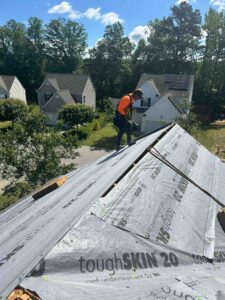Add Your Heading Text Here
Preparing your roof for extreme weather conditions is crucial for safeguarding your home and preventing costly damage. Extreme weather, such as heavy rain, high winds, hail, and snow, can place significant stress on your roof. By taking proactive measures, you can help ensure your roof remains intact and performs effectively during severe weather events. Here are some comprehensive steps to prepare your roof:
1. Conduct a Thorough Roof Inspecti on
Begin by inspecting your roof for any signs of damage or deterioration. Look for missing or cracked shingles, damaged flashing, and any areas where the roof decking may be compromised. Pay close attention to areas around chimneys, vents, and skylights, as these are common spots for leaks. If you notice any issues, address them promptly to prevent further damage.
2. Clean and Maintain Gutters and Downspouts
Clogged gutters and downspouts can lead to water backup and damage to your roof and home. Regularly clean gutters and downspouts to ensure proper water flow. Remove leaves, twigs, and other debris that can obstruct water drainage. Consider installing gutter guards to reduce the frequency of cleaning and to prevent blockages.
3. Trim Overhanging Tree Branches
Overhanging tree branches can pose a risk during high winds or storms. Trim any branches that are close to or touching your roof to prevent them from causing damage. This will also help reduce the amount of debris that can fall onto your roof and clog gutters.
4. Reinforce Roof Flashing
Roof flashing is essential for directing water away from vulnerable areas of your roof. Inspect the flashing around chimneys, skylights, and vents for any signs of wear or damage. Make sure that the flashing is securely in place and properly sealed. If necessary, replace or reinforce the flashing to ensure it can withstand heavy rain and wind.
5. Upgrade to Storm-Resistant Materials
Consider upgrading to storm-resistant roofing materials if you live in an area prone to extreme weather. Impact-resistant shingles, metal roofing, and other durable materials are designed to withstand severe weather conditions better than standard roofing materials. Consult with a roofing professional to determine the best options for your home.
6. Ensure Proper Insulation and Ventilation
Proper insulation and ventilation are crucial for maintaining the health of your roof. Insufficient insulation can lead to ice damming in cold weather, while poor ventilation can cause excessive heat buildup in the attic. Ensure that your attic is properly insulated and ventilated to help prevent these issues.
By following these steps, you can better prepare your roof for extreme weather and protect your home from potential damage. If you have any concerns or need assistance with roof maintenance, contact a professional roofing contractor for a thorough inspection and expert advice.



